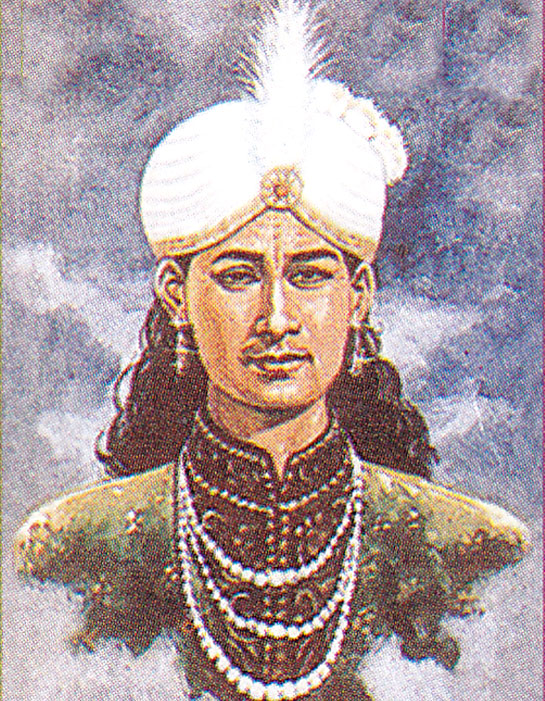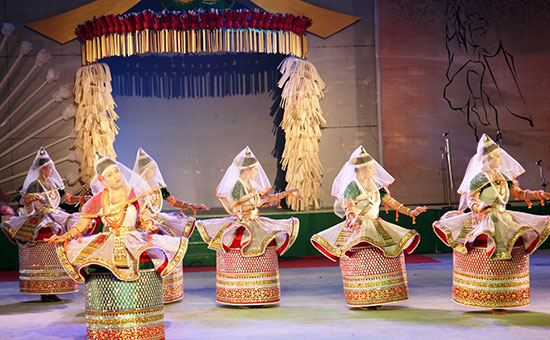- This article tells
you about the contribution of Rajarshi Bhagyachandra to modern day Manipuri
culture-forms of worship and Ras Leela. During his rule pre-Vaishnav Meitei
culture merged with Vaishnavism peacefully.
Many monarchs from
the annals of Indian history are still written about, talked about and
glorified as the defenders of Bharat as well as the saviours of Hinduism. The
constant onslaught of vicious attacks from invaders produced some of the
greatest warriors and upholders of Dharma but the mid 18th century remained
a perilous and vulnerable time for Hinduism. On one end the great Marathas were
fighting Ahmad Shah Durrani and on the other end the British East India Company
was quickly gaining a stronghold of the country. Indigenous Indian art, culture,
music and even literature was disappearing, with the influence of foreign
powers.
But tucked away in
the north east region, in the present day state of Manipur, history was taking
a very different turn.
Rajarshi
Bhagyachandra or Ching- Thang Khomba was born in 1740 and ruled Manipur for
forty years from 1759-1761 and 1763-1798.
Rajarshi Bhagyachandra (the lucky one) was called so because he is said to have received the blessings of Shri Govindaji. It was during Rajarshi’s reign that Hinduism reached its peak in Manipur.
His
contribution towards cementing the position of Hinduism in Manipur as well as
creating a movement rooted in Bhakti resulting in an unsurpassed vibrant
culture is still evident in Manipur but unfortunately forgotten and ignored in
the rest of the country.
Rajarshi’s contribution through development, mentorship and institutionalising of Vaishnavism in Manipuri society may not be measurable in any way but is certainly palpable in the spirited and in the civilised society that Manipur is. But his foremost contribution is in the unparalleled devotion to Shree Govindaji that the Manipuris have.
 Rajarshi’s image.
Rajarshi’s image.
Which would not have been possible if it wasn’t for the legendary vision of Rajarshi, who gave a new direction to Vaishnavism and enriched worship in its truest form through his active interest in making Vaishnavism inextricably a part of Manipuri daily life and culture. In 1776, he established the Shree
Govindaji Temple and inaugurated the divine idol of Radha Krishna and for
the first time began worship of the Lord in the Royal Palace.
In 1779 he went on to introduce the Raas Leela, which
ended up being recognised as one of the eight prominent classical dances of
India.
Due to the purity of devotion through expression in
the Raas Leela, the dance form is commonly accepted as the highest form of
spiritual expression and worship towards Shri Govindaji. The dance form is also
a prime example of the seamless merger of pre-existing Meitei beliefs with Vaishnav
philosophy. All the movements are symbolic and indicate the life and stories of
Krishna in Vrindavan.
The choreography is a spectacular
combination of 'Thang-Ta' (martial arts of Manipur), 'Sarit-Sarat' (unarmed Manipuri martial
arts) and 'Mukna Kangjei' war exercises), all emanating from the pre Hindu
culture of the state.
 Raas Leela Sangai Festival 2014.
Raas Leela Sangai Festival 2014.
Rajarshi, who saw the Bhakti aspects of Vaishnavism
as reverence to God further went on to establish the Nat
Sankirtana, a crucial form of worship in Manipur. An intricate
combination of rhythmic movement, music and rituals that till date permeates
every aspect of Manipuri life.
Similar to the Raas Leela, Nat Sankirtana provides
the uniqueness in Manipuri Vaishnavism. It is not only exclusive to Manipur but
is also syncretised with Pre Vaishnav Meitei culture. Further, to protect,
nurture and regulate this art through research, organisation as well as
regulation, Rajarshi Bhagyachandra founded an official institution known as Pala
Loishang of Nat Sankirtana which encompasses an array of arts performed to mark
religious occasions.
Today, the Nat Sankirtana has been listed in UNESCO’s Intangible Cultural Heritage of Humanity which is aimed at creating awareness and appreciation for heritage and culture of a community. Its inclusion was announced at the eighth session of the UNESCO Intergovernmental Committee in Baku, Azerbaijan in 2013.
Rajarshi Bhagyachandra’s work to promote Vaishnavism through the arts also included Wari-Liba
(Storytelling), from the Ramayana, Mahabharata, and other Puranas of Hinduism
as well as Lairik-Thiba-Haiba (recitation) of Hindu scriptures. He did this with the intention as reflected in his own words “May this lofty ideal of Bhakti inspire and guide us in all our activities and help achieve national integration on the basis of equality, fraternity and humanity and spirit of tolerance defying all barriers of sex, caste, creed, geographical limitations, racial diversities and distinction of social status, in the achievement of which lies our ultimate salvation, both as an individual and as a nation”.
It was this vision of Rajarshi that made Vaishnavism
in Manipur not just a state religion but a way of life.
The story of Manipur and its peaceful
adoption of Vaishnavism, not limiting to practise but creating a greater
culture holds a special place in Indian history.
Hinduism in India has experienced aggressive
proselytization and manipulation for time immemorial. The north east region of
the country has been probably the most effected by the advent of new religions
and missionaries. Just across the border from Manipur, in Nagaland the
destruction of the old has been replaced with the new, the eradication of
culture and history, the use of force or inducement to usher in new religious
movements has been apparent.
But in Manipur this amalgamation of Pre-Vaishnav Meitei culture with Hinduism led to a greater ideal which is the ‘Meiteisation of Hinduism”.
Under the guidance of Rajarshi
Bhagyachandra there was no destruction but just a unique creation of one of the
prime examples of the peaceful ethos of Hinduism.
Author Rami is an author and columnist. Her latest book co-edited is Rajarshi Bhagyachandra and Bhakti Movement in East Indian Literature. Cover and Kangla Fort pic by Sanjeev Nayyar.
Also read
1. Manipuri
Dances-Extending the Boundaries
2. Vaishnavism
in Manipur
3. Sangai
Festival 2014, Imphal